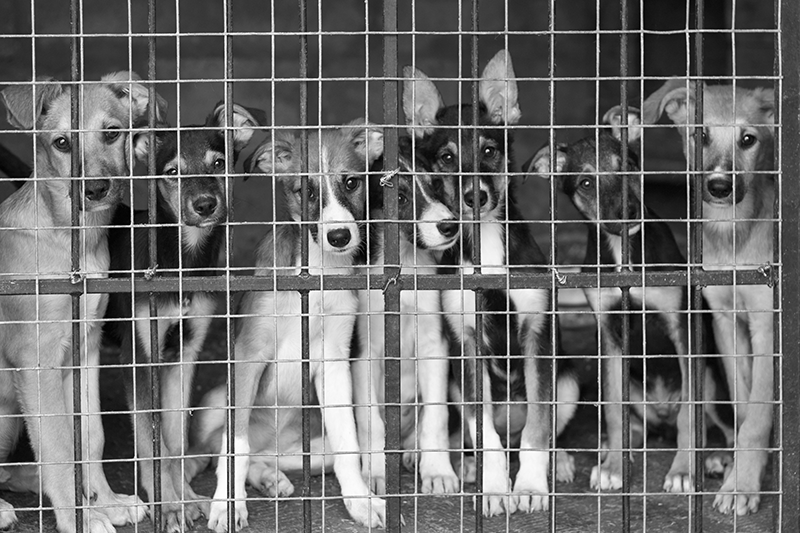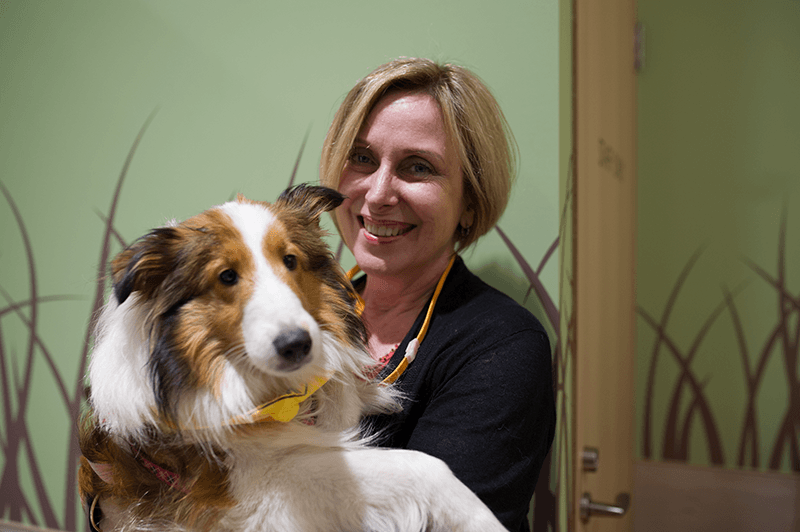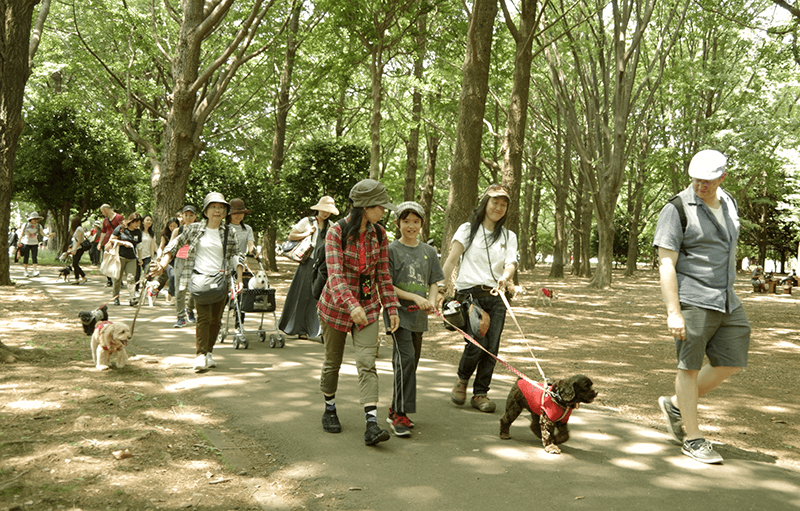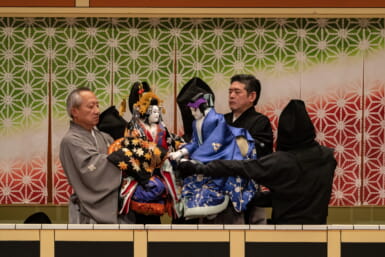Every year, Japan gasses 80 percent of the cats and dogs in its shelters, which receive around 200 animals a day. There are only two vets in the Kanto area who actively advocate spaying and neutering. The list goes on…
Elizabeth Oliver and ARK (Animal Refuge Kansai) representatives climbed the steps to a dog breeder’s property in Shiga. They were responding to claims about animal abuse, intending to capture evidence for the court. At least 30 Dachshunds, all in various states of starvation – or decay – lay in the owner’s back garden. When the owner spotted Oliver, they called the police. Oliver was arrested, and the breeder was not even so much as reprimanded.
It took another five years for ARK to bring this particular breeder to justice. Their business was suspended and they were ordered to pay ¥100,000. “You can’t force people to surrender an animal in Japan, no matter how much abuse is documented,” says Oliver. “And if you call the police, they will not even bother responding.”
This is why animal advocacy groups are so essential in Japan. Oliver founded ARK 25 years ago after being inspired by the late Rotraut Bomford, founder of JAWS (Japan Animal Welfare Society). After Bomford assisted Oliver in adopting a Great Dane that had been used for lab experiments, Oliver developed an interest in protecting animals. Today, Oliver’s NPO actively pursues cases, fighting in and out of court to gain awareness and help educate the public on animal welfare – all while finding homes for strays. “Around 90 percent of all pets in Japan are bought through pet shops. It needs to change. We are proud to be approaching it head on,” she says.
Pet Trends in Japan
“The ‘My Home’ movement, which happened in Japan in the 60s or 70s, started the idea that to have a complete home you needed a garden and a dog,” Oliver explains. At first, most pet owners opted to choose very “national” dogs, from the native Akita breed to the famed Shiba Inu. Cats were, in contrast, not popular until several decades later.
“Trendy” pet ownership came about after the release of the 1983 Japanese film “Antarctica,” which starred a cast of 17 huskies. The avalanche of families clamoring to own a husky was unprecedented. “But they learned, after a year or two, just how big they get, and [many of the huskies] were returned or discarded,” according to Oliver.
Lately, interest in smaller dogs has been increasing – so much so that breeders opt to keep runts of each litter, and breed them to maintain the miniature body structures. Dachshunds are longer. Poodles are smaller. Chihuahuas are daintier. “The physical sizes, and drive to keep breeding smaller dogs cosmetically causes issues in the future,” says Helen Marvell of Animal Advocacy and Animal Walk Tokyo. “It results in a number of painful medical conditions.”
Julie Okamoto of Tokyo ARK explains the repercussions: “The smaller the dog, the narrower the hips. Many female dogs [bought from pet shops or breeders] will be too small to give birth regularly. Most surgeries performed at clinics recently are C-sections.” Many breeders do the surgery themselves, forcing female dogs to give birth four or five times before disposal.
Then, behind the breeders you have the yakuza, Oliver claims. “They have the money and means to bring in an exotic array of animals and meet demands. In smaller prefectures the yakuza have infiltrated all factions of the community, the pet shops, breeders, police, and local government. It’s impossible to take them on.”
In Japan, each cycle of dog ownership rarely survives beyond two years, “[going] out of fashion, just like clothing,” says Oliver. Dachshunds, Chihuahuas, Shih-tzus, and terriers have all had their 15 minutes of fame. “In the late 90s there was a brief spike in interest in Dalmatians – credit Disney.”
The most recently sought-after pooch? “The Apricot Toy Poodle,” asserts Marvell. “The increase in pet cafés – for owls, cats, dogs and rabbits – encourages interest in other, sometimes more exotic, animals,” says Marvell. “The most recent is the hedgehog café – so now more pet shop owners are bringing in hedgehogs.” Likely trauma for small animals is “induced by being caged in unnatural habitats and frequently handled by customers … I’m certain in about two or three years, we will see many wandering in the parks or winding up at animal shelters.”
The Problem with Animal Shelters
Tokyo Zero, one of the groups behind 2014’s “No Kill” campaign, estimates that almost 311,000 dogs and cats were culled via the gassing method at shelters across Japan in 2014. According to the Ministry of Environment, the number is closer to 100,000. Although the numbers vary depending on the source, most sources indicate that between 82 to 88 percent of all animals at shelters in Japan will be put down, with roughly 11 percent being adopted. The remaining fraction is passed on to pet shops, kept for image, or sold to labs.
The reason for these high culling rates is overcrowding. Shelters receive around 200 animals a day, and manage to rehome an average of just two. Once an animal has been placed in a shelter, it has, depending on the prefecture, about three to seven days left to be adopted before the shelter must decide its fate.
The Gap in Regulations
“There were no regulations about owning a pet until 1973, when they enacted the Control Animal Act [now called the Act on Welfare and Management of Animals] in time for the Queen [of England]’s visit,” states Oliver. Originally the purpose was to show the Corgi-loving royal that Japan “had dogs in mind, too.” But in 1998 the government passed a stipulation requiring re-visitation of the law every five years to update animal and pet owner regulations.
In 2013, there was an amendment to the law that stated a person may be imprisoned for destroying an animal without proper reason. This amendment was promoted publicly using the slogan, “A dog is for life,” and shortly afterwards Tokyo Zero’s “No Kill” campaign picked up steam. But while “dogs are for life” is a great message in theory, Okamoto raises some concerns about the law: “Elderly people moving into nursing homes end up leaving their animals on the streets because they can’t take them with, but they also can’t legally return the pet.” Oliver adds: “Even if a dog is riddled with cancer and in pain, a vet following this regulation, or a shelter that is ‘no kill,’ will not put it to sleep. It’s just another form of animal abuse.”
The Act does not include any laws pertaining to shelters. If anyone submits a complaint about a shelter, an official may stop by for inspection, but it is unclear what procedures would follow a check-up. The very first, and only, case of an established pet-selling business being shut down by the government took place in 2015. The Papillon Tropical Fish shop in Akishima had been in business for over 40 years, and close to 100 complaints against it had been collected by the Tokyo Metropolitan Government center, all of them voicing concern about “unethical and unhygienic” practices, “stench and inhumane treatment,” says Maho Cavalier, an advocate and animal welfare legal advisor for ALIVE. “They were ordered to suspend business for one month, but now they are back in business.”
“A shelter or pet shop is more likely to get shut down if they evade paying taxes than if they abuse animals,” remarks Okamoto.
Many have rallied around politicians to change the method of animal culling. But of all Japan’s prefectures, Kumamoto is the only one to significantly change the way its shelters deal with animals. There, gas is prohibited from being used. “In other places, like Nara and Tokushima, residents said they didn’t feel comfortable with gassing “on premises” of shelters. So the shelters merely found a loophole, says animal advocate Masatoshi Ito. He tells of the “dream truck,” where animals are loaded at the end of the week and driven to the crematorium. On the way, the driver pushes a “release” button, sending gas into the back of the truck. Regardless of whether the animals are still alive or not, they are dumped into the incinerator. “Nobody can pinpoint the location where the gassing happens, so nobody can bring a case against them to stop it.”
Cavalier is optimistic about changing all of these aspects of animal culture in Japan. “I think people just don’t know about the externalities that are harming animals. Educating the general public and consumers is really important and is key to securing better animal rights in the future.”
The Future of Dogs in Japan
Amidst claims of many volunteers having PTSD from “compassionate fatigue,” the groups standing up for animals in Japan keep marching on. “We look for people who aren’t just ready to help, but are ready to have mercy for an animal that has suffered a long time, and can’t be helped any more,” implores Oliver. “When we go to court, we are looking for change in the laws, over time. It is not necessarily about targeting or making money or putting breeders away.”
Cavalier believes that Japanese pet owners’ hearts are in the right place, but they might be unsure of how to get involved and make a difference. “There are plenty of Japanese people who love animals and like having pets, so animal advocates should take advantage of this in their animal welfare awareness efforts.”
This year, ARK is celebrating reaching nintei status as an NPO, which means they are now fully recognized by the government and will begin receiving benefits. In Sasayama, Oliver and ARK representatives recently opened a new kind of shelter intended to re-establish the image of “going to the pound” in Japan. All materials to build the shelter were brought in from England with the help of the UK’s Dogs Trust group. “The cages are large with glass fronts, are well lit, and have play areas,” says Oliver, explaining that presentation is important to Japanese people, so she and her team aim to redesign and set a trend in shelters across the country.
Machiko Nakano, a volunteer and representative of Tokyo ARK, believes we need to reduce the numbers of the abandoned by raising the age at which puppies and kittens can be sold, and by finding more veterinarians who are not afraid to spay or neuter pets. There are currently only two vets in the Kanto area who openly and actively advocate spaying and neutering. One of them is Kuwosawa Yasushi, based in Yokohama, and he provides monetary incentives to pet owners who choose to proceed with the operation, which typically costs three times as much as it does in Western nations.
Some animal advocacy groups, such as Animal Walk Tokyo, host regular adoption fairs, shelter tours, campaigns, and sanpo (walk) events to spread awareness. “In Kobe, we have started a kids’ program among the Girl Scouts, showing them how to care for pets,” says Nakano. “As things are now, Japan still has another 100 years before animal rights are truly adopted,” she says. “We need teach people how to protect them. We need to stop saying ‘oh, poor thing’.”
Note: Some names have been changed to protect identities due to ongoing investigations and privacy concerns.
How You Can Help
If you are living in Japan temporarily, animal rights advocates advise you not to buy or even adopt a pet while here. Instead, volunteer at adoption fairs, play with dogs and cats at shelters on weekends, and donate to an animal charity. All of the groups below welcome donations and volunteers.
Useful Contacts
Tokyo ARK: www.arkbark.net/en/
Animal Advocacy Japan: www.facebook.com/animaladvocacyjapan
ALIVE: www.alive-net.net/english/index.html
Animal Walk Tokyo: www.animalwalktokyo.org
Dog Shelter: www.dogshelter.jp
Reading up on animal regulations: www.japaneselawtranslation.go.jp/law/detail/?id=61&vm=04&re=01
[Editor’s note: in the introduction, an earlier version of the piece states that there are only two vets in Japan who advocate spaying and neutering. That has been corrected to state that there are only two vets in the Kanto area who actively advocate spaying and neutering.]
Updated On April 27, 2018












